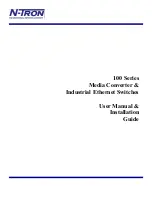
User Manual rev. 1.2. Aug. 2015
67
Parameter description:
System Configuration
Mode :
Indicates if Limit Control is globally enabled or disabled on the switch. If globally disabled,
other modules may still use the underlying functionality, but limit checks and corresponding
actions are disabled.
Aging Enabled :
If checked, secured MAC addresses are subject to aging as discussed under Aging Period .
Aging Period :
If Aging Enabled is checked, then the aging period is controlled with this input. If other
modules are using the underlying port security for securing MAC addresses, they may have
other requirements to the aging period. The underlying port security will use the shorter
requested aging period of all modules that use the functionality.
The Aging Period can be set to a number between 10 and 10,000,000 seconds.
To understand why aging may be desired, consider the following scenario: Suppose an
end-host is connected to a 3rd party switch or hub, which in turn is connected to a port on
this switch on which Limit Control is enabled. The end-host will be allowed to forward if the
limit is not exceeded. Now suppose that the end-host logs off or powers down. If it wasn't for
aging, the end-host would still take up resources on this switch and will be allowed to
forward. To overcome this situation, enable aging. With aging enabled, a timer is started
once the end-host gets secured. When the timer expires, the switch starts looking for
frames from the end-host, and if such frames are not seen within the next Aging Period, the
end-host is assumed to be disconnected, and the corresponding resources are freed on the
switch.
Port Configuration
The table has one row for each port on the selected switch and a number of columns, which
are:
Port :
The port number to which the configuration below applies.
Mode :
Controls whether Limit Control is enabled on this port. Both this and the Global Mode must
be set to Enabled for Limit Control to be in effect. Notice that other modules may still use the
underlying port security features without enabling Limit Control on a given port.
Limit :
The maximum number of MAC addresses that can be secured on this port. This number
cannot exceed 1024. If the limit is exceeded, the corresponding action is taken.
The switch is "born" with a total number of MAC addresses from which all ports draw
whenever a new MAC address is seen on a Port Security-enabled port. Since all ports draw
from the same pool, it may happen that a configured maximum cannot be granted, if the
remaining ports have already used all available MAC addresses.
Action :
If Limit is reached, the switch can take one of the following actions:
None:
Do not allow more than Limit MAC addresses on the port, but take no further action.
Trap:
If Limit + 1 MAC addresses is seen on the port, send an SNMP trap. If Aging is
disabled, only one SNMP trap will be sent, but with Aging enabled, new SNMP traps will be
sent every time the limit gets exceeded.
Shutdown:
If Limit + 1 MAC addresses is seen on the port, shut down the port. This implies
that all secured MAC addresses will be removed from the port, and no new address will be
learned. Even if the link is physically disconnected and reconnected on the port (by
disconnecting the cable), the port will remain shut down. There are three ways to re-open
Summary of Contents for AW-GEV-264A Series
Page 66: ...User Manual rev 1 2 Aug 2015 66...
Page 185: ...User Manual rev 1 2 Aug 2015 185 values...
Page 197: ...User Manual rev 1 2 Aug 2015 197 Clear Clears the counters for all ports...
Page 243: ...User Manual rev 1 2 Aug 2015 243 Refresh Click to refresh the page...
Page 323: ...User Manual rev 1 2 Aug 2015 323 6 Click the Save button to save your configuration...
















































